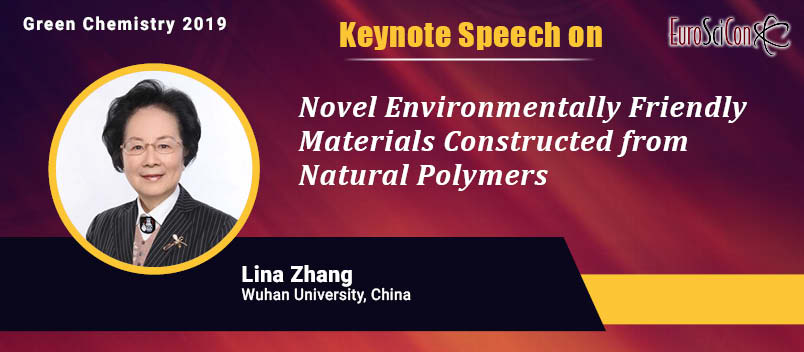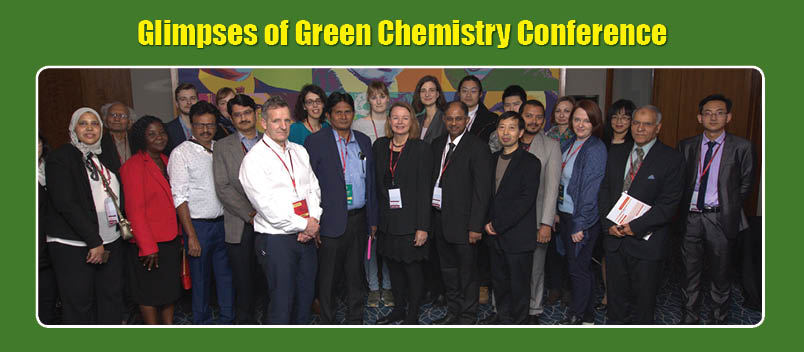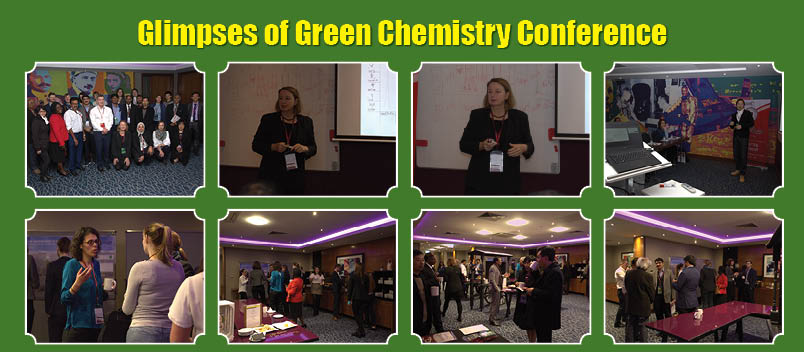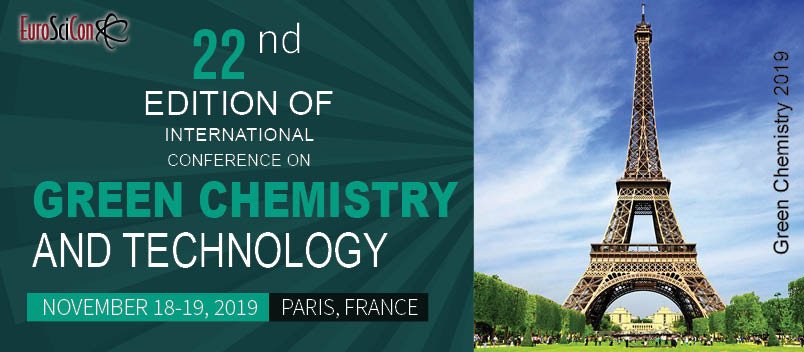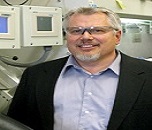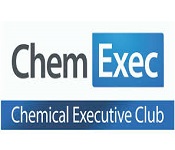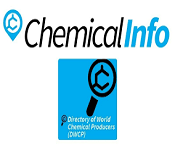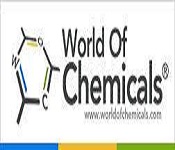Green Chemistry 2019
Sessions and Tracks
Green Chemistry is a type of chemical research and engineering. It is the design of chemical products and processes that reduce or eliminate the use or generation of hazardous substances. Green Chemistry applies across the life cycle of a chemical product, including its design, manufacture, use, and ultimate disposal. Green chemistry is also known as sustainable chemistry. Green chemistry aims to design and produce cost-competitive chemical products and processes that attain the highest level of the pollution-prevention hierarchy by reducing pollution at its source. Remediation may include separating hazardous chemicals from other materials, then treating them so they are no longer hazardous or concentrating them for safe disposal. Most remediation activities do not involve green chemistry. Remediation removes hazardous materials from the environment. On the other hand, green chemistry keeps the hazardous materials out of the environment in the first place. Green chemistry is the use of chemistry for pollutant source reduction. Therefore, all aspects of chemical processes that reduce impact on human health and on the environment. Its goal is to improve the quality of life and the competitiveness of industry by encouraging the design of products and processes that reduce or eliminate the use and generation of hazardous substances, For example by developing alternative syntheses for important industrial chemicals.
Track 1: Green Chemistry In Pharmaceutical Industries
Green chemistry is being employed to develop revolutionary drug delivery methods that are more effective and less toxic and could benefit millions of patients. Phosphoramidite-based, solid-phase synthesis of antisense oligonucleotides has been modified to accommodate principles of green chemistry by eliminating the use and generation of toxic materials and allowing reuse of valuable materials such as amidites, solid-support and protecting groups, thus improving the atom economy and cost-efficiency.
Track 2: Analytical Methods In Green Chemistry
The growing interest in green chemistry requires fresh perspectives on analytical extractions. Reduced solvent consumption, alternative safer solvents, and reasonable energy demands must be balanced with traditional analytical considerations such as extraction yield and selectively. This session deals with some of the concepts behind green chemistry and discusses green solvent selection and extraction techniques. An overview of alternatives to conventional solvents, new green solvents, ionic liquids, and other solvent options will be discussed in this scientific discussion.
Track 3: Applications Of Green Chemistry And LCA
Polysaccharides polymers: These are biological feedstock, and as such have the advantage of being renewable, as opposed to those feedstocks which are the product of petroleum. On the other hand, these have no chronic toxicity to human health and environment. Commodity chemicals from glucose: glucose is another alternative for commodity chemicals by using glucose in place of benzene, can help in minimizing the use of certain reagents with certain toxicity. The conduction of synthesis in water instead of organic solvents is more beneficial. The use of CO2 as a substitute for organic solvents already represents a tool of waste reduction in chemical industry.
Track 4: Biodegradation
Biodegradation is nature’s waste management and recycling system. It breaks down everything from yard waste to crude oil. It is a natural process necessary to keep our planet clean and healthy. “A process by which microbial organisms transform or alter (through metabolic or enzymatic action) the structure of chemicals introduced into the environment.” Basically, organic (carbon-based) material is changed through chemical processes from complex molecules into simpler molecules, eventually returning the molecules into the environment. For example, a banana peel can be reduced from cellulose to water, carbon dioxide gas, and humus in a compost pile.
Track 5: Biomass & Bioenergy
Biomass is an energy resource derived from plant- and algae-based material that includes crop wastes, forest residues, purpose-grown grasses, woody energy crops, algae, industrial wastes, sorted municipal solid waste, urban wood waste, and food waste. Biomass is the only renewable energy source that can offer a viable supplement to petroleum-based liquid transportation fuels—such as gasoline, jet, and diesel fuel in the near to mid-term. It can also be used to produce valuable chemicals for manufacturing, as well as power to supply the grid. A collaborative and multidisciplinary in-depth analysis by the U.S. Department of Energy determined that the United States has the capacity to sustainably produce over 1 billion tons of biomass annually—and still meet demands for food, feed, and fiber. Bioenergy is renewable energy made available from materials derived from biological sources. Biomass is any organic material which has stored sunlight in the form of chemical energy. As a fuel it may include wood, wood waste, straw, manure, sugarcane, and many other by-products from a variety of agricultural processes. Bioenergy is one of the many diverse resources available to help meet our demand for energy. It is classified as a form of renewable energy derived from biomass organic material that can be used to produce heat, electricity, transportation fuels, and products.
Track 6: Biopolymer & Bioplastics
Biopolymers are polymers synthesized by living organisms. Biopolymers can be polynucleotides (such as the nucleic acids DNA and RNA), polypeptides (that is, proteins) or polysaccharides (that is, polymeric carbohydrates). This consist of long chains made of repeating, covalently bonded units, such as nucleotides, amino acids or monosaccharides. Bioplastic is a biodegradable material that come from renewable sources and can be used to reduce the problem of plastic waste that is suffocating the planet and polluting the environment. As an alternative, the use of bioplastics is being promoted, consisting in obtaining natural polymers from agricultural, cellulose or potato and corn starch waste. These are 100% degradable, equally resistant and versatile, already used in agriculture, textile industry, medicine and, over all, in the container and packaging market, and biopolymers are already becoming popular in cities throughout Europe and the United States for ecological reasons: they are known as PHA.
This product is expected to cover the needs of 10% of the European plastics market within 10 years.
Advantages of bioplastics:
They reduce carbon footprint
They are providing energy savings in production
They do not involve the consumption of non-renewable raw materials
Their production reduces non-biodegradable waste that contaminates the environment
They do not contain additives that are harmful to health, such as phthalates or bisphenol A
They do not change the flavor or scent of the food contained
Track 7: Eco Friendly Materials
Eco-friendly literally means earth-friendly or not harmful to the environment. This term most commonly refers to products that contribute to green living or practices that help conserve resources like water and energy. Eco-friendly products also prevent contributions to air, water and land pollution. You can engage in eco-friendly habits or practices by being more conscious of how you use resources. Eco Friendly are sustainability and marketing terms referring to goods and services, laws, guidelines and policies that claim reduced, minimal, or no harm upon ecosystems or the environment. Companies use these ambiguous terms to promote goods and services, sometimes with additional, more specific certifications, such as ecolabels. Their overuse can be referred to as greenwashing
Track 8: Future Trends In Green Chemistry
VOC reduction enables better indoor and outdoor air quality, and decreases human exposure to pollutants, Dow’s low-or no-VOC solutions cost less than more traditional compounds, Dow’s low or no-VOC solutions meet sustainability requirements without compromising the quality of the product.The manufacture of computer chips requires excessive amounts of chemicals, water, and energy. Estimates indicate that the weight of chemicals and fossil fuels required to make a computer chip is 630 times the weight of the chip, as compared to the 2:1 ratio for the manufacture of an automobile.
Track 9: Green Catalysis
Catalysis has come a long way and has served industry well in enabling many reactions to be done which, otherwise, would have been uneconomic or even impossible. Today chemists are faced with new challenges as concerns for the environment and scarcity of resources motivates them to look for greener processes. Biocatalysis is the main green chemistry technology adopted by the fine chemicals and pharmaceutical industries to manufacture chemicals with higher yield. Heterogeneously catalyzed processes using supported metal or molecular catalysts are still an exception.
Track 10: Green Chemistry
Green chemistry emerged from a variety of existing ideas and research efforts (such as atom economy and catalysis) in the period leading up to the 1990s, in the context of increasing attention to problems of chemical pollution and resource depletion. The development of green chemistry in Europe and the United States was linked to a shift in environmental problem-solving strategies: a movement from command and control regulation and mandated reduction of industrial emissions at the "end of the pipe," toward the active prevention of pollution through the innovative design of production technologies themselves.
For a technology to be considered Green Chemistry, it must accomplish three things:
- It must be more environmentally benign than existing alternatives.
- It must be more economically viable than existing alternatives.
- It must be functionally equivalent to or outperform existing alternatives.
Green Chemistry presents industries with incredible opportunity for growth and competitive advantage. This is because there is currently a significant shortage of green technologies: we estimate that only 10% of current technologies are environmentally benign; another 25% could be made benign relatively easily. The remaining 65% have yet to be invented! Green Chemistry also creates cost savings: when hazardous materials are removed from materials and processes, all hazard-related costs are also removed, such as those associated with handling, transportation, disposal, and compliance. Through Green Chemistry, environmentally benign alternatives to current materials and technologies can be systematically introduced across all types of manufacturing to promote a more environmentally and economically sustainable future.
Track 11: Green Chemistry & Sustainable Process
Green chemistry metrics serve to quantify the efficiency or environmental performance of chemical processes and allow changes in performance to be measured. The motivation for using metrics is the expectation that quantifying technical and environmental improvements can make the benefits of new technologies more tangible, perceptible, or understandable. This, in turn, is likely to aid the communication of research and potentially facilitate the wider adoption of green chemistry technologies in industry.
Track 12: Green Chemistry In Environment
Environmental science is the multidisciplinary study of all aspects of the Earth’s physical and biological environments. It encompasses environmental chemistry, soil science, ecology, climatology, vegetation cover, marine and freshwater systems, as well as environmental remediation and preservation, and agriculture and land use. It also covers topics like Environmental Chemistry, Carbon footprint, Co2 capture, Greenhouse effect and many more. The natural greenhouse effect is caused by greenhouse gases which occur naturally in the earth’s atmosphere. The main natural greenhouse gases are carbon dioxide (CO2), methane (CH4), nitrous oxide (N2O), and water (H2O). These gases absorb and re-radiate the sun’s heat, helping to warm the planet and providing a temperature range that is suitable for life as we know it. Without these natural greenhouse gases, the temperature of the earth’s atmosphere would be approximately 34 degrees Celsius lower than it is today.
Track 13: Green Chemistry In Industries
Chemical synthesis using biodegradable materials (bioplastics, biopolymers) and syntheses using biomass-derived building blocks, High atom economy synthesis, Solvent elimination and sustainability assessment of solvents, Utilization of techniques and technologies that minimize energy and maximize reaction efficiency. Biocatalysis is the main green chemistry technology adopted by the fine chemicals and pharmaceutical industries to manufacture chemicals with higher yield. Heterogeneously catalyzed processes using supported metal or molecular catalysts are still an exception
Track 14: Green Energy
Green chemistry also plays a key role in alternative energy science, and the production of new ways to make solar cells, fuel cells, and batteries for storing energy.According to a recent analysis, solar photovoltaic technology is “one of the few renewable, low-carbon resources with both the scalability and the technological maturity to meet ever-growing global demand for electricity.” The use of solar photovoltaics has been growing at an average of 43% per year since 2000. In recent years, clean energy experts have been very excited about the emergence of two new chemistry-driven solar technologies, perovskite solar cells and quantum dots.
Track 15: Green Engineering
Green engineering approaches the design of products and processes by applying financially and technologically feasible processes and products in a manner that simultaneously decreases the amount of pollution that is generated by a source, minimizes exposures to potential hazards (including reducing toxicity and improved uses of matter and energy throughout the life cycle of the product and processes) as well as protecting human health without relinquishing the economic efficiency and viability. As such, green engineering is not actually an engineering discipline in itself, but an overarching engineering framework for all design disciplines.
Green engineering is the design, commercialization, and use of processes and products in a way that reduces pollution, promotes sustainability, and minimizes risk to human health and the environment without sacrificing economic viability and efficiency. Green engineering embraces the concept that decisions to protect human health and the environment can have the greatest impact and cost-effectiveness when applied early, in the design and development phase of a process or product.
Principles of Green Engineering
- Green engineering processes and products:
- Holistically use systems analysis and integrate environmental impact assessment tools.
- Conserve and improve natural ecosystems while protecting human health and well-being.
- Use life-cycle thinking in all engineering activities.
- Ensure that all material and energy inputs and outputs are as inherently safe and benign as possible.
- Minimize depletion of natural resources.
- Strive to prevent waste.
- Develops and applies engineering solutions while being cognizant of local geography, aspirations, and cultures.
- Creates engineering solutions beyond current or dominant technologies; improves, innovates, and invents (technologies) to achieve sustainability.
- Actively engages communities and stakeholders in the development of engineering solutions.
Track 16: Green Environmental Toxicology
There are number of approaches that can be used to support chemical risk assessment. Ideally, predictive tools identify hazards to be avoided; for example, it may be possible to identify a compound property or structural features that are associated with adverse effects. Such computational tools that exploit existing toxicology information can be used to ascertain potential relationships between chemical space and toxicological response. The outputs from these analyses can be used to define project-specific, toxicology experiments to determine if the predicted toxicities are real and so influence compound design.
Track 17: Green Nanotechnology
There are several proposed remediation techniques that use nanotechnology. For example, solar photocatalysis using titanium dioxide nanoparticles can degrade pollutants like volatile organic compounds and nitrous oxides and consequently has been used in cement and commercial plants. Paints enriched with Nano titanium dioxide, replacing organic biocides, are used to keep the surfaces of buildings clean.Soil remediation of abandoned and old military and industrial sites has become a great challenge in industrialized nations. Trials have been set-up using Nano zero-valent iron and iron oxides and the results have been quite promising. However, there are environmental concerns regarding the impact of nanoparticles on the soil.
Track 18: Green Organic ChemistryGreen chemistry seeks to reduce chemical related impact on human health and the environment by the use of alternative, environmentally friendly processes and reaction media. The selection of solvents, the chemicals used to dissolve substances into a solution, are a key target within Green Chemistry.
Track 19: Green Polymers & Green Materials
Green Polymers is a innovative technology to replace traditional materials with the ecofriendly substances. Polystyrene-Aluminium Chloride: It is used to prepare Ethers from alcohols. Polystyrene AlCl3 is a useful catalyst for synthetic reactions which require both a dehydrating agent and a Lewis acid. Thus, acetals are obtained in good yield by the reaction of aldehyde, alcohol and polymeric AlCl3 in an organic inert solvent. Polymeric super acid catalysts: This polymeric super acid catalysts are obtained by aluminium chloride to Sulfonate Polystyrene.
Track 20: Green Separations
Green Separations is defined by the separations of molecules, elements or substances in a sustainable method which does'nt harm the environmet in any form. It also know as the Ecofriendly separations and it is an alternative way to make separations in industries.
Track 21: Green Solvents
Solvents are consumed in large quantities in many chemical syntheses as well as for cleaning and degreasing. Traditional solvents are often toxic or are chlorinated. Green solvents, on the other hand, are generally derived from renewable resources and biodegrade to innocuous, often naturally occurring product.Moreover, owning to its high polar character one can expect novel reactivities and selectivities for organometallic catalysis in water. Furthermore, this provides an opportunity to overcome a serious shortcoming of homogenous catalysts.
Track 22: Green Sustainable Agriculture
Green Chemistry and sustainable agriculture are inherently intertwined; farmers need green chemists to make safe agricultural chemical inputs. Green Chemists need farmers practicing sustainable agriculture to provide truly “green” bio-based raw materials to process into new products. Practitioners of sustainable agriculture seek to integrate three main objectives into their work: a healthy environment, economic profitability, and social and economic equity. Every person involved in the food system—growers, food processors, distributors, retailers, consumers, and waste managers—can play a role in ensuring a Green and Sustainable Agricultural system.
Track 23: Green Synthesis
Green chemistry or sustainable approach to synthesize the molecules or Nano particles, which ultimately reduces or eliminates the uses of hazardous chemicals and substances. Green Synthesis is describing the method to eliminate the hazardous substances.
Track 24: Green Technology
Green Technology give rises to the technology which doest harm the environment in any ways & it also meant to be recycleable. It stops the environment being polluted at the source or manufacturing level. If a technology reduces or eliminates the hazardous chemicals used to clean up environmental contaminants, this technology would qualify as a green chemistry technology. One example is replacing a hazardous sorbent [chemical] used to capture mercury from the air for safe disposal with an effective, but nonhazardous sorbent. Using the nonhazardous sorbent means that the hazardous sorbent is never manufactured and so the remediation technology meets the definition of green chemistry.
Track 25: Market Analysis And GC3
The enzyme industry has experienced significant growth during the last decade due to the global, growing demand for cleaner and greener technology to preserve the environment.
According to BCC Research, the global market for industrial enzymes is expected to grow from nearly $5.0 billion in 2016 to $6.3 billion in 2021, demonstrating a five-year compound annual growth rate (CAGR) of 4.7%. As a segment, food industrial enzymes should approach $1.5 billion and $1.9 billion in 2016 and 2021, respectively, growing at a five-year CAGR of 4.7%. Animal feed industrial enzymes, as a segment, is forecast to total $1.2 billion and nearly $1.6 billion in 2016 and 2021, respectively, reflecting a five-year CAGR of 5.2%. This market segment is expected to rise due to higher investments in renewable sources of energy and increased demand for animal feed products.
The GC3 commissioned this research from Environmental & Public Health Consulting to support its efforts to mainstream green chemistry by understanding barriers and opportunities to accelerating green chemistry adoption across supply chains. Metrics play a critical role in understanding if green chemistry design, policy, business, or educational efforts are leading us towards desired outcomes. The purpose of this Green Chemistry & Commerce Council (GC3) report is to identify and characterize metrics that can be used to measure progress in green chemistry.
Track 26: Pollution Prevention
Green Chemistry reduces or eliminate the impact the hazardous substances which pollute the environment drastically. The researches invent & innovate the products, molecules which is eco- friendly. Green chemistry is the design of chemical products and processes that reduce or eliminate the use or generation of hazardous substances. Green chemistry applies across the life cycle of a chemical product, including its design, manufacture, use, and ultimate disposal. Green chemistry is also known as sustainable chemistry.
Green chemistry:
- Prevents pollution at the molecular level
- Is a philosophy that applies to all areas of chemistry, not a single discipline of chemistry
- Applies innovative scientific solutions to real-world environmental problems
- Results in source reduction because it prevents the generation of pollution
- Reduces the negative impacts of chemical products and processes on human health and the environment
- Lessens and sometimes eliminates hazard from existing products and processes
- Designs chemical products and processes to reduce their intrinsic hazards
Track 27: Renewable & Recyclable Materials
Renewable materials are also knon as sustainable materials, these materials do not use up non-renewable resources. They can also be produced in high enough volume to be economically useful. Biopolymers are one such renewable material. A biopolymer is a naturally occurring polymer, such as carbohydrates and proteins. Some examples of biopolymers are cellulose, starch, collagen, soy protein and casein. These raw materials are abundant and biodegradable, and are used to make diverse products such as adhesives and cardboard. Recyclable materials include many kinds of glass, paper, and cardboard, metal, plastic, tires, textiles, and electronics. The composting or other reuse of biodegradable waste—such as food or garden waste—is also considered recycling. Materials to be recycled are either brought to a collection center or picked up from the curbside, then sorted, cleaned, and reprocessed into new materials destined for manufacturing. PHAs are biodegradable plastics, they are used as an energy and carbon storage compound within certain bacterial cells. The industries are looking forward to replace the Plastics, which are non-Bio degradable.Some of the biodegradable biopolymers are compostable: they can be put into an industrial composting process. Biodegradable polymers have an innumerable use in the biomedical field, particularly in the fields of tissue engineering and drug delivery.
Track 28:
Sustainable ChemistrySustainable chemistry is a scientific concept that seeks to improve the efficiency with which natural resources are used to meet human needs for chemical products and services. Sustainable chemistry encompasses the design, manufacture and use of efficient, effective, safe and more environmentally benign chemical products and processes. Sustainable chemistry is also a process that stimulates innovation across all sectors to design and discover new chemicals, production processes, and product stewardship practices that will provide increased performance and increased value while meeting the goals of protecting and enhancing human health and the environment.
Benefits of Sustainable Chemistry
The environmental and societal benefits of sustainable chemistry include:
- Avoiding the use of persistent, bioaccumulative, toxic, and otherwise hazardous materials
- Using renewable resources and decreasing consumption of non-renewable resources
- Minimising negative environmental impacts of chemical processing and manufacturing
- Providing technologies that are economically competitive for and advantageous to industry
Track 29: Waste Management
Waste management plays a major role in the field of Green Chemistry as its give ways to reduce waste in an effective way as it innovates methods to manage waste without harming the environment, ultimately it reduces the pollution. Waste management or waste disposal are all the activities and actions required to manage waste from its inception to its final disposal. This includes amongst other things collection, transport, treatment and disposal of waste together with monitoring and regulation. It also encompasses the legal and regulatory framework that relates to waste management encompassing guidance on recycling.
About Conference
EuroSciCon invites all the participants from all over the world to attend “22nd Edition of International Conference on Green Chemistry and Technology’’ during November 18-19, 2019 at Paris, France which includes prompt keynote presentations, Oral talks, Poster presentations, Workshops and Exhibitions.
Green Chemistry and Technology 2019 is a global overview with the Theme: “Focusing on the sustainable development for the better future” is designed for professionals at all levels and career phases of the Chemical industry, Pharmaceutical industry and Petroleum industry, who want to improve their understanding of what will drive and shape the future of the market. This will include senior executives, sales and marketing personnel, strategic planners, who will be benefit from a broad overview of the Chemical, Pharmaceutical and petroleum industry. The strength of the Conference is that the participants tend to include all phases of the value chain as well as individuals from a wide variety of sector and countries. This experience helps the conference to be an interactive forum and encourages a strong level of dialogue and discussion, thus maximising the benefits of attendance. This conference surely provides better information and insight into the development of the world Chemical industry, which in turn has enabled attendees to make better and more profitable decisions.
Why to attend our Conference
It promotes the positive contributions of Green Chemistry by:
- Highlighting the material and chemicals beneficial Physical and chemical properties and its positive contributions to society throughout its life cycle
- Providing society with educational information to help raise awareness and correct misconceptions
- Liaising with European and national institutions in policy matters to secure decisions based on accurate information
- Communicating plastics contribution to sustainable development, innovation and quality of life
- Initiating in depth studies and sharing experiences.
Target Audience for Green Chemistry and Technology 2019
Eminent Scientists/ Research Professors in the field of Green Chemistry, Chemical, Pharmaceutical, Toxicology, Polymer and petroleum, Junior/Senior research fellows, Students, Directors of Chemical research companies, Chemical Engineers, Members of Chemistry associations and exhibitors from Chemical, Pharmaceutical, Petroleum and Polymer Industry/Plastic Industries.
Market Analysis
The global market for green chemistry, which includes bio based chemicals, renewable feed stocks, green polymers and less-toxic chemical formulations, is projected to grow from $11 billion in 2015 to nearly $100 billion by 2020.
According to Pike Research, the North American market for green chemistry is projected to grow from $3 billion to over $20 billion during the same period. Renewable chemicals are derived from bio-based feed stocks using environmentally friendly production technologies has been gone global. BCC Research estimates in its new report the global chemical industry will grow to over $1.5 trillion per year when bio-based and renewable products replace existing products and provide new revenue sources to companies and regional economies.
Renewable chemicals or bio-based chemicals are obtained from renewable sources such as biomass, organic waste products, microorganisms, agricultural waste and agricultural feed stocks are used to produce other chemicals. They are used in various applications across different industries such as in pharmaceuticals, housing, transportation, textiles, environment, hygiene, and food processing. The manufacture of lubricants and surfactants, resins, consumer goods, and plastics for environmental purpose use renewable chemicals.
The global market for renewable chemicals is expected to grow from $51.7 billion in 2015 to $85.6 billion by 2020, with a compound annual growth rate (CAGR) of 10.6% for the period of 2015-2020. Raw materials for renewable chemicals production, which ranked second at a 40.6% market share in 2014, is expected to fall to 35.5% during the forecast period (2015-2020) due to the uptake of alternative feedstock used in the production process.
The enzyme industry has experienced significant growth during the last decade due to the global, growing demand for cleaner and greener technology to preserve the environment.
According to BCC Research, the global market for industrial enzymes is expected to grow from nearly $5.0 billion in 2016 to $6.3 billion in 2021, demonstrating a five-year compound annual growth rate (CAGR) of 4.7%. As a segment, food industrial enzymes should approach $1.5 billion and $1.9 billion in 2016 and 2021, respectively, growing at a five-year CAGR of 4.7%. Animal feed industrial enzymes, as a segment, are forecast to total $1.2 billion and nearly $1.6 billion in 2016 and 2021, respectively, reflecting a five-year CAGR of 5.2%. This market segment is expected to rise due to higher investments in renewable sources of energy and increased demand for animal feed products.
Growing consumer awareness towards renewable chemicals and increasing environmental concerns are driving their growth in the market. In addition, regulators in the U.S., U.K. and E.U. have formulated rules concerning the manufacture and disposal of petrochemicals, which have helped to boost the renewable chemicals consumption during the past few years as companies seek compliance.
Energy supply chain issues are an important market driver. Fossil fuel-based resources are finite in stock and face continuing and increased demand. Almost 80% of available raw materials and energy sources are consumed by close to 20% of the developed world's population. China and India, both of which have populations of over 1 billion people, are exhibiting rapid economic growth, which is boosting demand for energy and chemicals production.
Learn More
Top Green Chemistry Universities Worldwide:
Green chemistry Universities | Green Chemistry Conferences:
Peking University | University of Cambridge | University of Tokyo | Zhejiang University | Nanjing University |Kyoto University | California Institute of Technology |Chemistry Conferences | University of Chicago | Fudan University | University of Oxford | University of Science and Technology of China | Georgia Institute of Technology | Osaka University | Swiss Federal Institute of Technology Zurich | Green Chemistry Meetings| Korea Advanced Institute of Science and Technology| Environmental Chemistry Conferences | University of California | Green Chemistry Conferences | Imperial College | University of Wisconsin | East China University of Science and Technology | Sustainable Chemistry Conferences | Dalian University of Technology | EuroSciCon | Xiamen University |University of Illinois | Green Chemistry Conferences | EuroSciCon Conferences | University of Michigan | Jilin University | Nankai University |University of Toronto | Tohoku University | Princeton University | University of North Carolina | EuroSciCon Conferences | University of Minnesota | National Taiwan University | Sustainable Chemistry Conferences | University of Pennsylvania | Seoul National University | Cornell University | University of California | Shanghai Jiao Tong University | Green Chemistry Conferences | Texas A&M University |Pennsylvania State University | Chemistry Conferences| Pohang University of Science and Technology
Europe Green Chemistry Universities | Green Chemistry Conferences:
University of Graz | University of Innsbruck |Montanuniversität Leoben | Johannes Kepler University | Green Chemistry Conferences | Ghent University | Ruaer Boskovia Institute | University of Split | Green Chemistry Conferences | University of Zagreb | Charles University | Palacký University |University of Pardubice | Green Chemistry Meetings| University of Copenhagen | Aalto University |University of Grenoble | Institute for Research in Organic Fine Chemistry | National Graduate School of Engineering Chemistry | Lille University | University of Lyon | Chimie paris tech | Laboratory Analytical Sciences | Sustainable Chemistry Conferences| University of Poitiers | University of Pau and Adour Country | University of Reims Champagne | University of Strasbourg | University in Aachen | University of Bayreuth | Chemistry Conferences | Technical University of Berlin | Free University of Berlin |EuroSciCon | Ruhr University Bochum | University of Bonn | University of Alicante | Environmental Chemistry Conferences | University of Barcelona |EuroSciCon Conferences | University of the Basque Country | University of Cádiz | University of Extremadura | EuroSciCon Conferences | University of Granada | University of Jaén | University of Oviedo |University of Santiago de Compostela | University of Valladolid | University of Vigo | University of Zaragoza |Chemistry Conferences | Stockholm university |University of Bradford | University College Cork | Green Chemistry Conferences | Masaryk University | Robert Gordon University | Sheffield Hallam University |University of Southampton | University of Warwick
USA Green Chemistry Universities | Green Chemistry Conferences:
Brigham Young University | California State University |California State University | Case western Reserve University | Clarkson University | Cleveland State University | EuroSciCon | Florida State University |Georgetown University | The George Washington University | Green Chemistry Conferences | Governors State University | Howard University | Illinois Institute of Technology | Indiana University | Kansas State University | Kent State University | Chemistry Conferences | Marquette University | Miami University |Northeastern University | Green Chemistry Meetings| Old Dominion University | Oregon State University |Purdue University | New Brunswick Piscataway |EuroSciCon Conferences | Seton Hall University| Sustainable Chemistry Conferences | South Dakota State University | Stevens Institute of Technology |Tufts University | University of Cincinnati | University of Georgia | University of Louisville | Environmental Chemistry Conferences | University of Maryland |University of Missouri | University of Missouri | The University of Montana | University of Nebraska |University of Southern Mississippi | University of South Florida | EuroSciCon Conferences | The University of Tennessee | The University of Texas at Austin |University of Toledo | Vanderbilt University | Wake Forest University | Washington State University
Asia Green Chemistry Universities | Green Chemistry Conferences:
Nanyang Technological University | Tsinghua University | National University of Singapore | Peking University | University of Tokyo | Green Chemistry Conferences | Zhejiang University | Nanjing University |EuroSciCon | Kyoto University | Fudan University |University of Science and Technology of China | Green Chemistry Meetings | Osaka University | Korea Advanced Institute of Science and Technology | East China University of Science and Technology |Chemistry Conferences | Dalian University of Technology | Xiamen University | Jilin University |Nankai University | Tohoku University | National Taiwan University | Seoul National University | Shanghai Jiao Tong University | Environmental Chemistry Conferences | King Abdullah University of Science & Technology | Hong Kong University of Science and Technology | National Tsing Hua University | Indian Institute of Science | EuroSciCon Conferences | King Abdelaziz University | Indian Institute of Technology Bombay | University of Malaya | Istanbul Technical University | University Sains Malaysia | Indian Institute of Technology Madras | Middle East Technical University | National Cheng Kung University | Green Chemistry Conferences | Chulalongkorn University |King Fahd University of Petroleum and Minerals | Keio University | University Putra Malaysia | Ege University |Jiangsu University | Southwest University | Green Chemistry Conferences | National Taiwan University of Science and Technology | Tel Aviv University |Sustainable Chemistry Conferences | Chonbuk National University | Donghua University | Hiroshima University | Green Chemistry Meetings | Beihang University | Waseda University | Technion Israel Institute of Technology | Tongji University
Africa Green Chemistry Universities | Green Chemistry Conferences:
University of Capetown | University of Pretoria |University of south Africa | University of the Witwatersrand | University of KwaZulu | Universities Stellenbosch | University of Johannesburg | North-West University | Green Chemistry Confrences| University of Nairobi | University of the Western Cape| Green Chemistry Meetings | The American University in Cairo | University of Ibadan | Cairo University |Rhodes University | Nelson Mandela Metropolitan University | University of free state | Makerere University | Cape Peninsula University of Technology |Addis Ababa University | Egerton University | University of Ghana | University of Nigeria | University of Lagos |Kenyatta University | Sustainable Chemistry Conferences | Obafemi Awolowo University | Tshwane University of Technology | EuroSciCon | Durban University of Technology | Covenant University |Kwame Nkrumah University of Science and Technology | Mansoura University | Ahmadu Bello University | Ain Shams University | EuroSciCon Conferences | Jimma University | Cheikh Anta Diop University | Chemistry Conferences | Alexandria University | University of Khartoum | University of Fort Hare | Federal University of Technology | The German University in Cairo | University of Botswana | University of Abou Bekr Belkaïd | University of Ilorin | Benha University | Environmental Chemistry Conferences| Jomo Kenyatta University of Agriculture and Technology | Assiut University | Sudan University of Science and Technology | Helwan University |University of Abuja | EuroSciCon | University of Zimbabwe | Vaal University of Technology
Green Chemistry Societies | Green Chemistry Conferences:
ACS Division of Analytical Chemistry | Subdivision of Chromatography and Separations Chemistry |Analytical Chemistry Springboard | Analytical Sciences Digital Library | Green Chemistry Conferences| National Registry of Certified Chemists | Society for Applied Spectroscopy | The Japan Society for Analytical Chemistry | Green Chemistry Meetings |ANACHEM Association of Analytical Chemists | Division of Analytical Chemistry EuCheMS | Israel Analytical Chemistry Society | Society for Analytical Chemists of Pittsburgh | Association of Environmental Analytical Chemistry of India | Indian Society for ElectroAnalytical Chemistry | Asian Network of Analytical Chemistry | Egyptian Society of Analytical Chemistry | Green Chemistry Meetings | Society for Electroanalytical Chemistry | Federation of Analytical Chemistry and Spectroscopy Societies | Egyptian Society Of Analytical Chemistry | EuroSciCon Conferences | Analytical & Life Science Systems Association | Association of Analytical Communities Research Institute | German Association of Independent Testing Laboratories | Society for the Advancement of Applied Optics, Optoelectronics, Quantum Electronics and Spectroscopy | Chemistry Conferences | Indian Analytical Instruments Association | International Mass Spectrometry Foundation | Japan Analytical Instruments Manufacturers Association | Leibniz Institute for Analytical Sciences | Society for Applied Spectroscopy| International Association of Environmental Analytical Chemistry | British Mass Spectrometry Society |African Network of Analytical Chemists | Australian and New Zealand Society for Mass Spectrometry |Federation of Asian Chemical Societies | Belgian Society for Mass Spectrometry | Canadian Society for Mass Spectrometry | Hong Kong Society of Mass Spectrometry | Green Chemistry Conferences| Egyptian Chemical Society | Egyptian Society of Analytical Chemistry | Egyptian Society of Biochemistry and Molecular Biology | Indian Society for Mass Spectrometry | Indian Society for Electro analytical Chemistry | Royal Society of Chemistry |Sustainable Chemistry Conferences | Society for Analytical Chemists of Pittsburgh | The Japan Society for Analytical Chemistry | Israel Society for Analytical Chemistry | Chromatographic Society of India |German Society for Mass Spectrometry | The International Association for the Advancement of High Performance Thin Layer Chromatography | Czech Chemical Society | European Association for Chemical and Molecular Sciences | European Federation for Pharmaceutical Sciences | European Society for Separation Science Italian Chemical Society | Royal Netherlands Chemical Society | Chemistry Conferences | Swedish Mass Spectrometry Society |Swedish Chemical Society | The Israeli Society for Mass Spectrometry | American Organization of Analytical Chemists International | American Society for Mass Spectrometry | Green Chemistry Conferences| Association of Separation Scientists and Technologists | Austrian Society for Analytical Chemistry | Canadian Society for Analytical Science and spectrometry | Environmental Chemistry Conferences | Cooperation on International Traceability in Analytical Chemistry | International Council of Chemical Associations Society for Applied Spectroscopy | South African Chromatography Society| EuroSciCon | Chromatography and Electrophoresis Group of the Czech Chemical Society | Separation Sciences Foundation of Denmark Denmark Association Francophone des Sciences Separatives |German Chemical Society | Hungarian Society for Separation Science | Italian Society for Separation Science | Ukranian Chromatographic Society | Spanish Society for Chromatography and Associated Techniques | EuroSciCon Conferences | Slovenian Chemical Society, Slovenia Polish Chemical Society |Norwegian Chromatographic Group | Norwegian Chemical Society
Europe Green Chemistry Conferences | Green Chemistry Conferences:
5th International Polymer Chemistry Conferences May 06-07, 2019 Amsterdam, Netherlands | 13th International Electrochemistry Conferences May 27- 28, 2019 Barcelona, Spain | 6th Global Summit on Pollution Control Conferences May 06-07, 2019 Amsterdam, Netherlands | 11th World Recycling Conferences June 13-14, 2019 Edinburgh, Scotland | 7th World Green Energy Conferences June 24-25, 2019, Barcelona, Spain | 10th World Green Chemistry Congress July 10-11, 2019 Paris, France | 5th Edition Of International Polymer Science Conferences Amsterdam, Netherlands | 15th International Environmental Chemistry Conferences August 15-16, 2019 Rome, Italy | 6th World Climate Change Conferences September 02-03, 2019 Berlin, Germany | 2nd Annual Green Catalysis Conferences and Sustainable Energy Conferences November 14-15, 2019 | 7th World Green Energy Conferences June 24-25, 2019 Barcelona, Spain | 6th Global Climate Change Conferences October 20-21, 2019 Amsterdam, Netherlands | Environmental Toxicology Conferences and Health Safety Conferences November 25-26, 2019 Valencia, Spain | 6th World Chemical Engineering Conferences and Catalysis Conferences July 15-16, 2019 Amsterdam, Netherlands | 14th Global Summit and Expo on Biomass Conferences and Bioenergy Conferences August 26-27, 2019 Vienna, Austria | 13th World Biofuels Conferences and Bioenergy Conferences August 26-27, 2019 Vienna, Austria | 11th Bioenergy Congress and Biofuels Congress November 28-29, 2019 Helsinki, Finland | 8th International Petro Chemistry Conferences and Oil-Gas Marketing Conferences July 15-16, 2019 Amsterdam, Netherlands
USA and Canada Green Chemistry Conferences | Green Chemistry Conferences:
18th International Industrial Chemistry Conferences & Water Treatment Conferences April 26-27, 2019 Vancouver, British Columbia | 6th International Polymer Chemistry Conferences & Materials Engineering Conferences August 02-03, 2019 Chicago, USA | 6th World on Climate Change Congress and Global Warming Congress April 24-25, 2019 Vancouver, Canada | 3rd International Renewable Conferences and Smart Energy Resources Conferences July 29-30, 2019 Chicago, USA | International Polymer Waste Conferences – Biopolymers Conferences & Bioplastics Conferences September 25-26, 2019 Toronto, Ontario, Canada
Asia and Middle-East Green Chemistry Conferences | Green Chemistry Conferences:
8th World Climate Congress May 10-11, 2019 Bangkok, Thailand | 2nd World Environmental Toxicology Conferences and Health Conferences June 10-11, 2019, Osaka, Japan | 7th World Earth Congress and Environmental Science Conferences August 21-22, 2019 | Holiday Inn Atrium, Singapore | 6th World Green Chemistry Conferences and Recycling Conferences October 14-15, 2019 Seoul, South Korea | 3rd International Natural Hazards Conferences and Disaster Management Conferences October 23-24, 2019 Tokyo, Japan | 8th International Biodiversity Conservation Conferences and Ecosystem Management Conferences November 11-12, 2019 Tokyo, Japan | 12th World Expo on Recycling Conferences and Waste Management Congress December 02-03, 2019 Tokyo, Japan | International Environmental Microbial Biofilms Conferences and Human Microbiomes Conferences December 16-17, 2019 Dubai, UAE | 8th International Climate Change Conferences and Medical Entomology Conferences December 16-17, 2019 Dubai, UAE | 9th World Biopolymers Congress and Polymer Chemistry Congress July 15-16, 2019 Bangkok, Thailand | 11th Asia Pacific Congress on Oil Conferences and Gas Conferences September 23-24, 2019 Hong Kong | 10th World Convention on Biopolymers Conferences & Bioplastics Congress October 23-24, 2019 Tokyo, Japan | 6th World Chemical Engineering Conferences and Catalysis Conferences November 27-28, 2019 Singapore | 4th World Petroleum Congress and Refinery Congress May 20-21 2019 Osaka Japan | International Petrochemistry Conferences and Chemical Engineering Conferences November 04-05, 2019 Tokyo, Japan | 2nd World Oil, Gas and Petroleum Refinery Conferences December 12-13, 2019 Dubai, UAE | 2nd Annual Environmental Pollution Conferences and Health Conferences October 21-22, 2019 Sydney, Australia | 10th World Convention on Recycling Congress and Waste Management Conferences October 21-22, 2019 Sydney, Australia
Past Conference Report
Green Chemistry 2018
The 21st Edition of International Conference on Green Chemistry and Technology was held on November 12-13, 2018 in Edinburgh, Scotland with the presence of professional researchers, business delegates, scientists involved in the development of high-quality education & research in all aspects. Please check the website: Green Chemistry 2018 Conference Photographs
Green Chemistry 2018 witnessed an amalgamation of peerless speakers who enlightened the crowd with their knowledge and confabulated on various topics related to the field of Green Chemistry, Sustainable Chemistry. The highly exalted conference hosted by EuroSciCon was marked with the attendance of renowned and brilliant researchers, business delegates and talented student communities representing more than 30 countries around the world. The conference has tried grounding every aspect related to Green Chemistry, covering all the possible research areas.
The conference aimed a parallel rail with theme “Endorsing the Importance of Sustainable World by Academic and Industrial Forum: Driving Waste towards Zero”. The meeting engrossed a vicinity of cognizant discussions on Green Catalysis, Green Synthesis, Green Solvents, Sustainable Chemistry, Green Organic Chemistry, Biopolymer & Bioplastics, Green Separations, Green Technology, Green Energy, Green Chemistry and Engineering, Green Chemistry in Pharmaceutical Industries. The three days event implanted a firm relation of upcoming strategies in the field of Green Chemistry with the scientific community. The conceptual and applicable knowledge shared, will also foster organizational collaborations to nurture scientific accelerations.
We are thankful to all our speakers for encouraging and supporting us to conduct the conference and catapulting the same to pinnacle of success.
We would like to thank our Organizing Committee Members Dr. Marcel Risch, University of Goettingen, Germany & Dr. László T Mika, Budapest University of Technology and Economics, Hungary for their support throughout the conference without their cooperation it’s impossible for us to reach the heights of success of Green Chemistry 2018 Conference
The Organizing Committee would like to thank the moderator Dr. Fabrizio Olivito, Magna Graecia University of Catanzaro, Italy for his valuable contribution which resulted in smooth functioning of the conference.
The meeting was embarked with an opening ceremony followed by Keynote Sessions and followed by series of lectures delivered by Honorable Guests and members of the Keynote forum. The highlights of the meeting were the eponymous lectures, delivered by:
László T Mika, Budapest University of Technology and Economics, Hungary
Matjaž Kunaver, National Institute of Chemistry, Slovenia
Marcel Risch, University of Goettingen, Germany
József M Tukacs, Budapest University of Technology and Economics, Hungary
Alexander N Buzynin, Russian Academy of Sciences, Russia
Alberto Tagliaferro, Polytechnic University of Turin, Italy
Maurizio Benaglia, University of Milan, Itlay
Fabrizio Olivito, Magna Graecia University of Catanzaro, Italy
Qurat Ul Ain Nadeem, University of Liverpool, UK
Mariam Al Saidi, Kuwait Institute for Scientific Research, Kuwait
Youssef Habibi, Luxembourg Institute of Science and Technology, Luxembourg
Green Chemistry 2018 had an effective networking session which enables the professionals and scientists to get involved & enlightened them in all perspectives. We also like to thank all the delegate professionals from various countries who attended the conference shared their industrials experiences in networking sessions. Please check the website: Green Chemistry 2018 Conference Photographs to visualize the conference photographs
EuroSciCon is prerogative to thank the Organizing Committee Members, Keynote speakers and Chairs on transcribing the plenary sessions in a diversified and variegate manner to make this conference an enviable artifact.
Green Chemistry 2018 would not have reached the pinnacle if not with the support of International, multi-professional steering committee and coordination of Insights in Trends in Green Chemistry Archives in Chemical Research and Journal of Organic & Inorganic Chemistry
With the grand success of Green Chemistry 2018, we are glad to announce our next upcoming conference “22nd Edition of International Conference and Exhibition on Green Chemistry and Technology” which is going to be held in Paris, France during November 18-19, 2019 on the theme " Focusing on the sustainable development for the better future"
Bookmark your dates…
Hoping to meet you again coming year at Paris, France!!!

